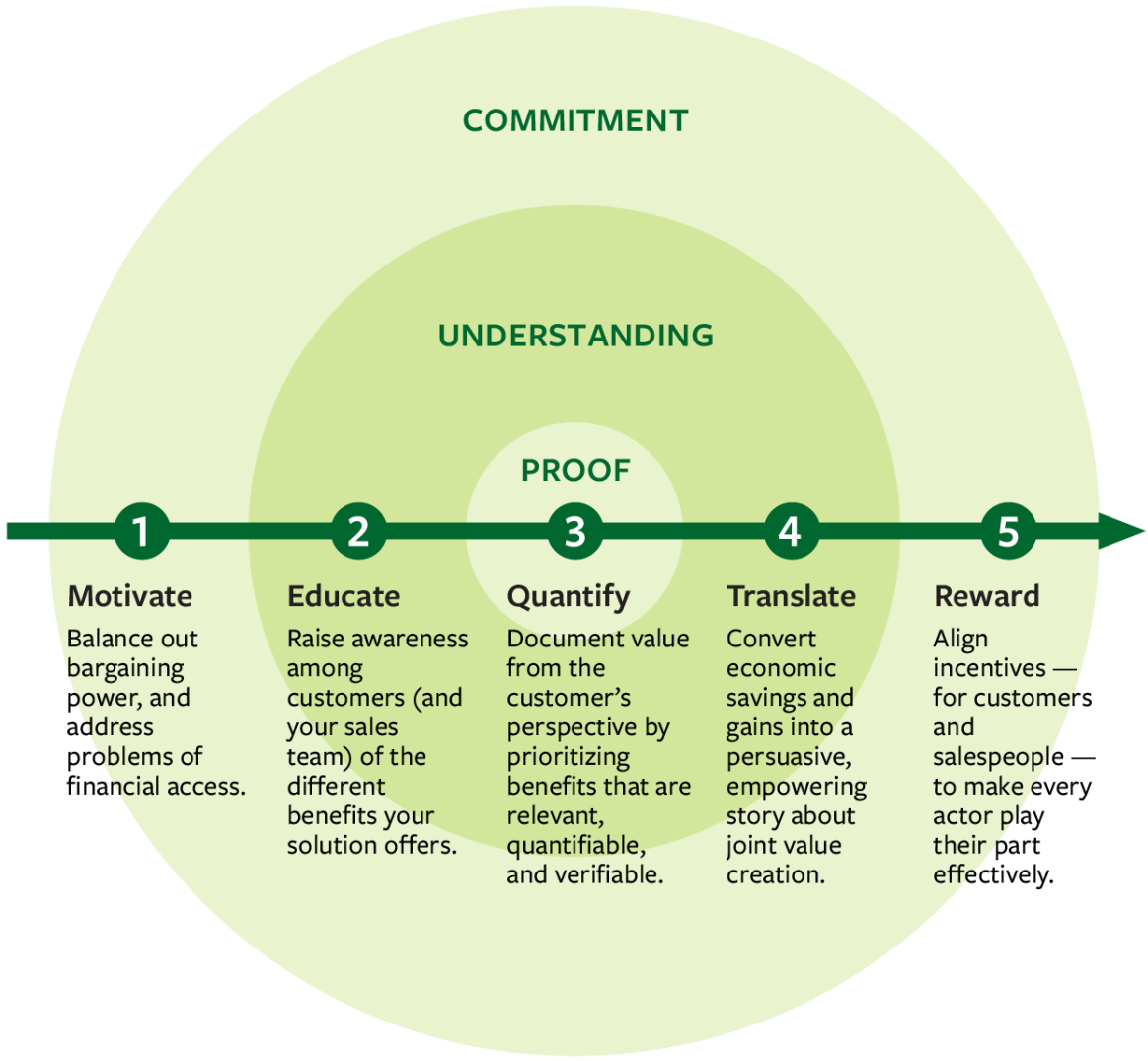Acing Value-Based Sales
To get the best returns on innovative products, collaborate with customers to define and share the commercial opportunity.
Topics
News
- CERN and Pure Storage Partner to Power Data Innovation in High-Energy Physics
- CyberArk Launches New Machine Identity Security Platform to Protect Cloud Workloads
- Why Cloud Security Is Breaking — And How Leaders Can Fix It
- IBM z17 Mainframe to Power AI Adoption at Scale
- Global GenAI Spending to Hit $644 Billion by 2025, Gartner Projects
- e& enterprise Partners with MIT Sloan Management Review Middle East for GovTech Conclave 2025

Mark Airs/Ikon Images
Imagine that burst of enthusiasm when a senior executive unveils a plan that promises a significant and lasting impact on the organization’s financial performance. “Our new product creates more value for our customers than anything else on the market, and we should get paid accordingly,” they proudly declare. “If we measure and communicate that value precisely, then we can finally get the return we deserve.”
The sales team buys into the logic. Now armed with a superior product, a sophisticated value calculator, and a host of new selling arguments, they quickly turn the senior executive into a prophet. Price, margin, and profit all improve significantly in the first quarter of implementation, with a smaller but still important increase the next.
A year later, however, few traces of the highly touted program remain. The selling arguments have gone stale. The state-of-the-art value calculator is dismissed as theoretical and complex. The early financial gains have evaporated as the sales team, under constant pressure from fierce buyers, returns to aggressive discounts to win the volume and customers lost at the outset.
Such sagas are an open secret in B2B markets around the world. Many companies embrace value-based selling programs, but few succeed in a significant, sustainable way. They invest heavily in product development, but frustration spreads when customers don’t understand the points of differentiation, never mind wanting to pay for them. The dream outcome of selling on value rather than cutting good deals never materializes, leaving a trail of demotivated salespeople and missed opportunities. Worst of all, lacking a clear return, companies postpone or cut back on investments — which reassures competitors that they can get away with mediocre offerings.
In our experience, value-based selling initiatives often start with the wrong premise. Senior executives assume that their company’s differentiated offerings deserve a higher price. In turn, this sense of entitlement lulls them into thinking that the only challenge is to quantify and communicate every advantage. Faced with hard numbers, they reason, any customer in their right mind would happily pay a premium.
However, in most commercial relationships, value is not at the sole discretion of the seller but cocreated with customers who play an active role in realizing desired outcomes. It follows that successful value-based sellers not only prove the added value of their products and services but also gain commitment from customers and foster a shared understanding of the opportunity.
Our framework, developed over years of helping companies achieve long-term returns from product development, grounds a five-part process for successful value-based sales in three key principles essential to such initiatives: commitment, understanding, and proof. (See “Engaging Customers in Value-Based Selling.”) Establishing commitment is required at the start to motivate customers to work with the sales team, and again at the end to reward customers appropriately. The drive to reach mutual understanding shapes the second step, where salespeople educate customers about the range of benefits offered by their solutions, as well as the fourth step, where they translate expected customer savings and gains into a compelling business case. At the center of our framework and the sales process is proof — because, ultimately, companies attract and retain customers only when they can quantify the value that their solutions add.
Engaging Customers in Value-Based Selling
Rooting the five-step sales process in the principles of commitment, understanding, and proof underscores that the seller is building a deeper relationship with the customer, not merely seeking to close a deal.

Best-in-class value-based selling realizes that “showing customers the money” is not enough. In this article, we will expand on each of these steps and explain how to tackle them in your business.
Motivate: Set the Context for Value Cocreation
The potential of a commercial opportunity may be clear, but it will fail to materialize if your company or the customer lacks the motivation to collaborate in creating and sharing value. The two key dimensions to motivation, the first step in our framework, are the balance of power between sides and the customer’s financial wherewithal.
Conventional wisdom calls for the party with the greater bargaining power to shape the deal in its favor. This results in higher prices and more stringent conditions when the seller has the advantage, and lower prices and more generous conditions when the buyer does. In this view, any codependence between the two parties relies more on force or acquiescence than on actual need or mutual choice.
But this perspective is myopic. The overconfidence that comes from having leverage tempts the dominant side to appropriate as much value as it can in the short term, meanwhile neglecting the opportunity to create greater value in the long run by working with the other side. When your company has the advantage, you should exercise self-restraint and pass up short-term gains for longer-term value creation. An excessively short-term focus fosters an arm’s-length relationship that keeps high prices top of mind for customers and encourages them to look for alternative suppliers. If the customer switches suppliers, you lose not only a revenue opportunity with a partner but also insights into product performance and customer benefits that can accrue only from long-term, repeated engagements. When the customer has the advantage, look to reduce its leverage by developing other customer relationships. You can also look for ways to influence the customer’s own customers to demand the value that you provide, such as via a stronger branding effort. The “Intel Inside” tag on personal computers is an example of how to drive awareness and end-user demand.
Buyers and sellers, then, have the best basis for joint value creation when the balance of power between them is relatively even. Yet, even with a level playing field, value creation will not happen unless customers have the money, time, and talent to purchase and properly implement a demonstrably better solution. Innovative offerings, especially those whose value accrues over time, are irrelevant if customers cannot afford them or cannot get them to perform to their potential.
Affordability was a barrier for global tire manufacturer Michelin when it introduced new products to its industrial customers. Its solution was to change the price metric such that, instead of selling customers the tires they needed for their fleets of trucks, Michelin retained ownership of the tires and invoiced on a per-mile-driven basis. The company not only improved access to better tires by spreading the burden of payment across time but also improved relationships: Low-consumption customers assumed less commercial risk (since they paid only when trucks were on the road) and could rely on Michelin’s expertise in the selection, repair, replacement, and recycling of tires to ensure that their fleets always had optimal equipment at hand. Michelin and its customers improved productivity and profitability because the common metric became a way to align their interests and not merely a clever way to pay for tires.
Motivating customers to participate in joint value creation is important, but it isn’t the only element of context-setting that your company needs to attend to. It’s also essential that customers understand the full extent of benefits that your products or services can bring.
Educate: Raise Awareness of Customer Benefits
A commercial opportunity relies on how well your company and your customers understand the benefits that drive value creation. The assistance of marketing and communications teams is critical at this point, in particular because benefits often accrue not only when a product is used but also at acquisition and disposal. At this step, the goal is simply to make customers question the wisdom of pushing on price.
Scot Forge, a 130-year-old metals forging company, succeeds with its value-based selling efforts because its teams think about value and price separately. They achieve this hard separation by focusing on a prospective customer’s biggest needs and challenges. In a joint process of discovery and exploration, Scot Forge and its customers create a standard vocabulary to define benefits and how the two parties will then quantify them.
They aren’t starting this process with a blank slate: Scot Forge maintains a long list of potential benefits for its products and services that is based on how the benefits are initially defined and measured. This standardization facilitates the discussions with buyers by providing a starting point. Many customers can intuitively judge whether the initial estimate of a benefit is too high or too low, but if asked directly, they would struggle to provide an accurate estimate of their own.
This process narrows down the list of benefits to what matters to each customer. Agreement on how to quantify the benefits is about more than mathematical formulas. The parties also agree on how accurate measurements should be. In reality, “close enough” is acceptably accurate for many measurements.
Such a process allows salespeople to set aside their assumptions regarding “this is what our solution does” to reach consensus on “this is how our solution helps you.” Salespeople in companies with a strong engineering culture may know, for example, that their new equipment has a smaller footprint and half the moving parts compared with a similar product offered by their main competitor. But outperforming competitors on one or more attributes does not guarantee that every customer will benefit from it.
Salespeople may also know that their solution has helped other companies reduce labor costs. But that benefit may not matter as much to a customer whose shops employ union labor or a customer that relies on offshore manufacturing to keep labor costs competitive. In another case, a company’s solution may yield a step change down in energy costs only after a certain volume threshold is reached. Salespeople need to know whether a prospective customer can at least meet that threshold, which would make the benefit worth prioritizing.
The number of benefits, and the mix between tangible and intangible benefits, is specific to an individual customer or, at most, to a segment of similar customers. Benefits such as less downtime, lower per-unit labor costs, or reduced energy consumption are easier to understand and quantify than potential increases in demand or higher brand awareness.
The business and technology consulting firm West Monroe succeeds with an approach similar to Scot Forge’s. The firm delivers value by advising organizations and implementing new technologies and ways of working, but those benefits are achieved only by changing people’s mindsets and behaviors. It’s about helping clients understand how new and different ways of working can deliver value across stakeholders.
Indeed, West Monroe saw an opportunity across the consulting industry. “Approximately half of our competitors’ clients didn’t feel that their consulting firm’s value delivered was greater than the fees charged,” said Casey Foss, West Monroe’s chief commercial officer. “That’s a big opportunity, but competing on financial results required us to be better at creating, optimizing, and communicating our value to clients.” The firm now tracks value-creation scores that rate the value received compared to fees paid. Those scores can be 32% higher among clients with whom it jointly quantifies value, because both parties are focused on the initiatives expected to have the greatest impact.
We’ve found very few companies engaging with customers the way Scot Forge and West Monroe do. We often encounter salespeople who lack the basic training to engage buyers in discussions about value and acknowledge the right trade-offs. Professional buyers are quick to point out that there are cheaper solutions available in the market; of course, there are always going to be competitors offering better deals. The issue is whether salespeople can help customers see — and quantify — the results they will be sacrificing to enjoy a better price.
Quantify: Solve the ABC Problem
Proof sits at the center of our framework because it is the fundamental part of any business transaction. Every commercial opportunity must be expressed in the medium customers use to gauge value. In most business markets, this medium is money. Your company’s task, then, is figuring out how your solution yields savings and gains — a challenge that we call the “ABC problem” because the path leads from product or service attributes to customer benefits to shared cash.
Solving the ABC problem is a numerical exercise that feeds on data and creativity. The data element is clear: Your company cannot substantiate claims without evidence of how an attribute or feature generates a benefit and how that benefit impacts the customer’s finances. This evidence, however, often arises when a solution is used, which implies that the customer must be enticed to share information. These enticements can include exclusive access to future innovations, consulting or other insights, temporary discounts, or other rewards.
But sellers should not underestimate the role of creativity and discovery. It is not always clear how the technical specifications of a given attribute can be expressed numerically as a benefit. One common misconception is that tangible benefits such as higher productivity or reduced energy consumption are relatively easy to convert into dollars and cents. Sometimes the tangible benefits are indirect. When a manufacturer introduced a new generation of machines that had a significantly lower operating temperature than its predecessors, its sales and marketing teams struggled at first to express the advantage in monetary terms. It turned out that the lower temperature meant the equipment required less lubrication, which translated into measurable savings for customers in terms of materials, labor, and waste disposal.
Another misconception is that intangible benefits such as brand equity or ease of use are nearly impossible to articulate in monetary terms. While there is some truth to this, blanket assumptions are dangerous if they lead companies to give up on quantifying intangible benefits too soon and use them as add-ons to sweeten the deal rather than as inputs to a better price. In many cases, intangible benefits represent a large part of the added value of an innovative product. If your company undersells or underestimates them, then it effectively renounces a good part of the margin it stands to make from the sale.
In our view, the impact of a benefit depends on the extent to which it fulfills the following criteria.
- Relevant: A customer needs to understand how it can capitalize on a given benefit. Superior towing capacity and cold-weather performance are wonderful innovations, but they mean nothing to a company that does little towing and never operates in cold weather. If your sales team doesn’t understand which benefits are relevant for a prospective customer, they risk dumping features into the offer indiscriminately or making every offer “all you can eat” for simplicity’s sake.
- Quantifiable: Is the relevant benefit observable and countable? Ideally, the customer can easily perceive a direct relationship between cause and effect. A heavy vehicle manufacturer may, for example, document that it has twice the towing capacity of its competitors and has superior cold-weather performance. But finding a concept and an equation to quantify a benefit is not sufficient. Quantification is possible only with a reliable flow of credible data. Does your company and the customer have the means in place to monitor performance and collect data? Do you have a central collection point that can serve as a single source of truth? The better the data, the better the company can estimate the value of the benefit.
- Verifiable: The customer still needs to realize the estimated benefits. This depends on cooperation between the buyer and seller to share data and agree on the calculations. Following up regularly after the sale gives your team a chance to observe how successfully the customer has implemented the solution and verify that the estimated benefits exist. You can work on corrective actions if the implementation or the benefits are falling short of expectations. Follow-up visits also provide additional data you can use to adjust claimed benefits for future sales. One way to support verification is to make the outcomes visible through a tool such as a value calculator tailored to the customer’s business.
These three criteria should be considered sequentially when deciding where to focus the sales effort. First, your company must identify the benefits that are relevant to the customer in question. From these relevant benefits, priority goes to the ones that are quantifiable. Then, among the quantifiable relevant benefits, the emphasis should be on the verifiable ones.
These criteria also determine the nature of the sales effort. The more a benefit satisfies all three criteria, the greater the underlying certainty that it is achievable. Your sales team can then focus on making direct comparisons to alternative and presumably inferior solutions. Indirect comparisons and general statements such as “a 1% improvement in this benefit yields $X million in savings” may not be meaningful to most customers, given that estimated and actual results often deviate significantly from an average. One buyer told us that if his company were to achieve all the savings that potential sellers have promised him in those “1%” claims, its savings would be greater than its actual costs. Such cynicism has prompted some buyers to insist on guarantees or other forms of risk sharing that compel sellers to take a more active role in ensuring that they achieve the estimated benefits.
For benefits that are relevant and quantifiable but not verifiable, your company owns the burden of proof. You can use mechanisms such as benchmarking, pilot tests, or samples to offset perceived risk by the customer. Finally, for benefits that are relevant but neither quantifiable nor verifiable, look to market research for support. When introducing data that comes from customer surveys, though, it is important to make sure respondents have sufficient prior experience with the product to validate their judgments, and an incentive to answer truthfully. You want credible and accurate data at hand as you move toward building a strong case in the next step.
Translate: Turn Impact Into a Compelling Business Case
Specialty chemicals company Borealis conducts value workshops with its potential customers to help them connect the prioritized list of quantified benefits to their day-to-day operations. “We build a customized model, and we present it step by step, validating our assumptions during the conversation,” said Paolo De Angeli, head of customer value management. This not only gets buy-in from customers but also enables Borealis and the customer to reach a common understanding of the differential value that the company creates. It also allows both parties “to identify opportunities for further value creation by working together as partners,” De Angeli added. The common metrics keep conversations focused on quantified value delivered.
We talk about translating impact because numbers seldom speak for themselves. Calculating the monetary gains from adopting a particular product is a must, but wrapping dry figures in language, visuals, and interfaces that resonate with customers is also critical. The more familiar the story feels, the more agency the customer will feel it has. Your company can use that as a call to action to cocreate value.
The most powerful business cases are stories that travel well, meaning that they retain meaning beyond the people directly involved with negotiating a deal — such as the senior executive who has final control over budget approval, the local manager who is responsible for implementing the company’s innovative product, and so on. This extended audience usually has limited time, a limited understanding of the context, and its own vernacular. Therefore, successful business cases feature the following.
- A small number of key messages: Benefits are not necessarily additive; less may be more. The choice of what benefits to communicate, in which order, can affect a buyer’s value perception. For example, juxtaposing a strong or resonating benefit with a less impactful one can diminish the perception of the more valuable benefit.
- The right amount of detail: It is better to share just enough detail to enable a decision and keep the information specific and relevant to the customer. When discussing the business case directly, your company can share more information if the listener indicates a need for it or asks a question. To help the business case travel better, you could include a brief Q&A in an appendix that anticipates and answers additional questions. Refraining from telling the whole story may be difficult for sellers who know their product back to front, because they may struggle to put themselves in the position of someone looking at the product for the first time. Salespeople need to resist the temptation to smother the customer with extraneous details.
- Clear next steps: The business case should include an operational framework that specifies the KPIs and the tools and data to measure and validate them. Creating a joint agreement for documentation and validation keeps your company involved after the sale closes and draws the attention of senior management beyond the buying team that negotiated the deal.
Reward: Align Interests With Smart Incentives
Any value-based selling effort must be coupled with strong incentives for the company and customers to create and allocate value over an extended period. With respect to the customer, incentives operate at two levels: the price metric and the price points.
Michelin and its customers in the mining sector agreed on a price metric — cost per mile driven — that aligned with the way the parties create value together. The more material the mine can transport more frequently over longer distances, the more productive the mine will be. Contrast this approach with setting a price per product and offering discounts ex post to adjust for observed outcomes. The money paid and received may be the same, but the latter process is far less collegial.
Early-stage motivation and late-stage incentives both belong in the commitment layer of our recommended process because the price points — the split of the value pie — need to reflect and maintain the stable balance of power established at the outset of the process. The split should reflect the proof behind benefits and the time frame of the agreement. A split that favors one party too strongly will eventually give the other party a disincentive to create additional value.
After moving through the first four steps of our framework, salespeople should be well prepared to counter requests for lower prices or larger scopes by making the appropriate price-value trade-offs. But they also need incentives to negotiate those trade-offs in a way that secures the best price for your company, which is usually neither the highest possible price nor a low price that cedes too much value to the customer. Specific incentives can include rewards for negotiating a price within a target range or for growing the value pie, or rewards that are inversely proportional to discount levels. This marks a significant shift for companies that have trained and rewarded their salespeople to meet revenue or volume goals rather than goals related to profit or prices.
How the buyer pays also makes a difference, and these payment methods and terms must be codified in advance. Let’s say a seller creates $10 million in mutually validated value for a customer over a two-year period. No matter how appreciative buyers are, few of them will have the willingness or even the authority to write a lump-sum check based on that value. Sellers can overcome these issues with financing options or with price metrics based on consumption, outcomes, or other parameters.
Closing the deal doesn’t mark the end of the transaction but rather the initiation of a new phase of the relationship. Tracking actual performance versus projected value allows your company to identify and resolve problems early and build a robust database for benchmarks. To ensure that it has a natural role in ongoing validation, for example, Michelin builds its models together with its customers, based on a common vision and goals.
In our experience, companies that implement our process for value-based selling start with two initiatives in parallel. First, they improve their ability to provide proof. Rigorous quantification is the core task for a reason. If your company does nothing else, this change will improve your sales efforts. Thinking through what is relevant, quantifiable, and verifiable ensures that business cases have a robust basis.
Second, they need to appoint a full-time value leader who is independent of sales and marketing. Marketing professionals tend to overshoot “soft” benefits such as brand and expertise. Apart from being wrong, this loses the trust of salespeople and complicates collaboration: Marketers blame sales for not being able to sell value; salespeople blame marketing for sending them into battle unprepared. If there is collective ownership of value throughout the organization, no function feels accountable for it, and each applies its own definitions and tools.
Appointing an independent value manager, then, marks the first move toward establishing commitment and understanding, the two outer layers of the framework. Marketing and communications support the process in promoting understanding, while finance and strategy have influence over commitment. The value leader also provides a powerful cross-check or counterweight by representing the customer’s interests as your company develops its plans for each step of the process.
Perhaps the most important task of the value leader, though, is to align the organization on a shared and respected definition of value: how to define it, measure it, and adapt it for an individual customer. This is the ultimate prerequisite for successful value selling because the term value can mean everything and nothing at the same time. Continuous attention to the ABC problem makes value a habit and enables salespeople to adapt the definition to an individual customer’s needs.
Companies that make our framework the basis for their value selling can also expand their target markets. We refer to this as key account management at scale. A standard definition of value, supported by the right tools and mindset, enables your company to define and quantify value for any customer — even small ones — and decide the best way to share that value.





